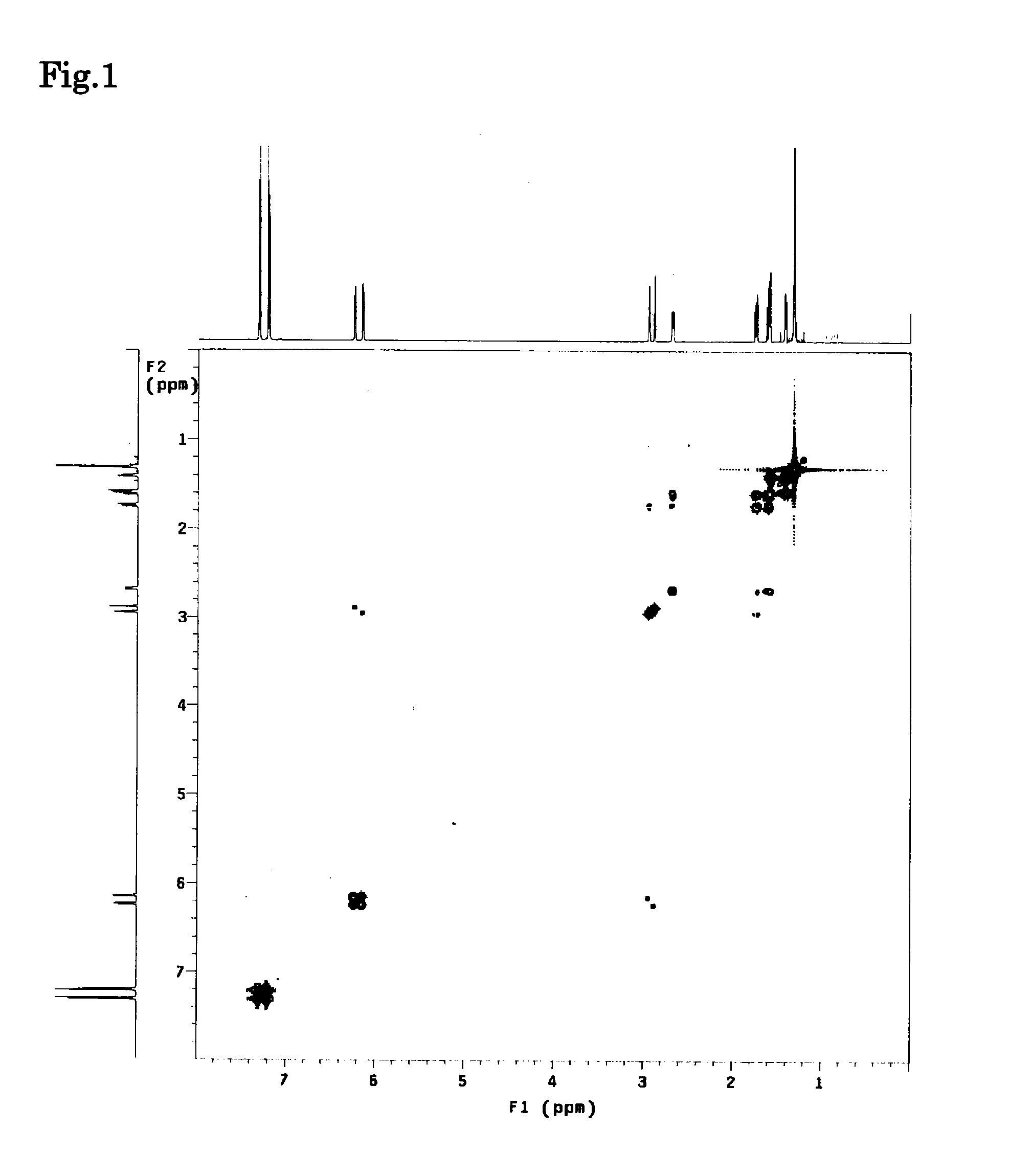Method for producing norbornene derivative
a technology of norbornene and derivatives, which is applied in the direction of hydrocarbon preparation catalysts, group 5/15 element organic compounds, halogenated hydrocarbon preparations, etc., can solve the problems of inability to produce only the exo isomer, inability to produce norbornene derivatives in which the configuration of the substituted phenyl group is an exo configuration, and inability to produce at a high yield. , to achieve the effect of simplifying the production process
- Summary
- Abstract
- Description
- Claims
- Application Information
AI Technical Summary
Benefits of technology
Problems solved by technology
Method used
Image
Examples
example 1
[0077]First, into a 1.0-L three-necked flask, 2-dicyclohexylphosphino-2′-methylbiphenyl (a phosphorus compound: 258 mg: 0.708 mmol), palladium acetate (13.3 mg:0.059 mmol), dimethyl sulfoxide (DMSO: 250 ml), norbornadiene (19.0 ml: 190 mmol), 4-tert-butylbromobenzene (10.0 ml: 59 mmol), triethylamine (NEt3: 26.7 ml: 192 mmol), and formic acid (5.9 ml: 154 mmol) were fed under a nitrogen atmosphere, and then heated with stirring under a temperature condition of 80° C. for 4 hours, to thereby obtain a reaction solution. Note that, in such a reaction solution, the content ratio of palladium acetate to 4-tert-butylbromobenzene was 0.1% by mole, the content ratio of the phosphorus compound to 4-tert-butylbromobenzene was 1.2% by mole, the molar equivalent of norbornadiene to 4-tert-butylbromobenzene was 3.22 equivalent, the molar equivalent of NEt3 to 4-tert-butylbromobenzene was 3.25 equivalent, and the molar equivalent of formic acid to 4-tert-butylbromobenzene was 2.61 equivalent.
[007...
examples 2 to 4
[0083]Each product was obtained in the same manner as in Example 1, except that a phosphorus compound described in Table 1 was used instead of 2-dicyclohexylphosphino-2′-methylbiphenyl. Note that the content ratio of each component in a reaction solution was the same as in Example 1. Table 1 shows the kind of the phosphorus compound used in each Example, the reaction temperature for the production step of each crude product, the conversions, and the yield of each compound.
TABLE 1ReactionYield ofYield ofYield ofYield ofPhosphorustemperatureConversionCompound ACompound BCompound CCompound Dcompound(° C.)(%)(%)(%)(%)(%)Example 18092.780.66.55.00Example 28087.078.65.82.10Example 3t-Bu3P8099.865.032.3 1.30Example 48064.757.02.35.00
example 5
[0088]Into a 0.1-L three-necked flask, tri-tert-butyl phosphorus (a phosphorus compound [the same phosphorus compound as that used in Example 3]:14.3 mg: 0.071 mmol), palladium acetate (1.3 mg:0.006 mmol), dimethylsulfoxide (DMSO: 25 ml), norbornadiene (1.8 ml: 19.0 mmol), 4-tert-butylbromobenzene (1.0 ml: 5.9 mmol), sodium hydroxide (NaOH: 0.77 g: 19.2 mmol), and formic acid (0.6 ml: 15.4 mmol) was fed under a nitrogen atmosphere, and then heated with stirring under a temperature condition of 80° C. for 4 hours to thereby obtain a reaction solution. Note that, in such a reaction solution, the content ratio of palladium acetate to 4-tert-butylbromobenzene was 0.1% by mole, the content ratio of the phosphorus compound to 4-tert-butylbromobenzene was 1.2% by mole, the molar equivalent of norbornadiene to the 4-tert-butylbromobenzene was 3.22 equivalent, the molar equivalent of NaOH to 4-tert-butylbromobenzene was 3.25 equivalent, and the molar equivalent of formic acid to the 4-tert-b...
PUM
| Property | Measurement | Unit |
|---|---|---|
| molar ratio | aaaaa | aaaaa |
| transparency | aaaaa | aaaaa |
| heat resistance | aaaaa | aaaaa |
Abstract
Description
Claims
Application Information
 Login to View More
Login to View More - R&D
- Intellectual Property
- Life Sciences
- Materials
- Tech Scout
- Unparalleled Data Quality
- Higher Quality Content
- 60% Fewer Hallucinations
Browse by: Latest US Patents, China's latest patents, Technical Efficacy Thesaurus, Application Domain, Technology Topic, Popular Technical Reports.
© 2025 PatSnap. All rights reserved.Legal|Privacy policy|Modern Slavery Act Transparency Statement|Sitemap|About US| Contact US: help@patsnap.com



